Vaccinating pregnant women to protect their newborns from pertussis appears to avert more cases of the disease, hospitalizations, and deaths than does vaccinating mothers immediately post partum, according to a report published online May 27 in Pediatrics.
In a decision-analysis modeling study, vaccination during pregnancy also was found to be more cost-effective than "postpartum cocooning" – a strategy of vaccinating close family contacts, ideally before the infant’s birth, and vaccinating the mother immediately post partum, said Dr. Andrew Terranella and his associates at the Centers for Disease Control and Prevention.
The U.S. Advisory Committee on Immunization Practices (ACIP) recommended the cocooning approach in 2005, but "programmatic challenges and institutional hurdles have prevented widespread implementation both in the United States and in other countries." In 2011, ACIP recommended vaccination during the second or third trimester as the preferred strategy. [Editor’s note: The new CDC immunization schedule, released in January 2013, recommends that a dose of the Tdap vaccine be administered to all women during each pregnancy, whether or not she has received the vaccine previously (MMWR 2013;62 [Suppl 1:9-19)].
Dr. Terranella and his colleagues compared the health benefits and costs of three approaches using a cohort model of the 4,131,019 infants born in the United States in 2009 and followed for 1 year.
They calculated the expected number of infant pertussis cases using information from a national database of notifiable diseases, assuming a conservative underreporting rate of 15%. Some studies have documented underreporting rates as high as 50%, they noted.
They calculated the probabilities of hospitalization, respiratory disease, encephalopathy, and death, given an annual rate of 62.6 cases of infant pertussis per 100,000 infants.
The model assumed 72% coverage of vaccination during pregnancy and the same rate of coverage for postpartum vaccination with and without and cocooning vaccination of the father in one grandparent. It also assumed vaccine effectiveness of 85%.
The model further assumed that transfer of maternal antibodies would be 100% and that the rate of infant protection would be 60% for the first 2 months of life. For postpartum vaccination, there would be a 2-week delay in protection of the infant, because it takes that long for sufficient antibodies to form in the mother after the inoculation.
The model showed that with no vaccination, an estimated 3,041 cases of infant pertussis would occur each year, causing 1,463 hospitalizations and 22 deaths. In comparison, postpartum vaccination alone could avert 596 infant cases annually, a 20% reduction from the base case. Postpartum vaccination with cocooning averted 987 cases annually, which represents a 32% reduction in incidence. Vaccination during pregnancy would avert even more – 1,012 cases each year, a 33% reduction in incidence, the investigators said (Pediatrics 2013 [doi:10.1542/peds.2012-3144]).
Vaccination during pregnancy prevented more infant deaths (a 49% reduction, compared with no vaccination) than did postpartum vaccination with cocooning (a 29% reduction). It also prevented more hospitalizations (a 38% reduction) than did postpartum vaccination with cocooning (a 32% reduction).
In addition, vaccination during pregnancy saved 396 quality-adjusted life years (QALYs) annually, compared with 253 QALYs saved with postpartum vaccination with cocooning.
The annual cost of vaccination during pregnancy was estimated to be $171 million, while that of postpartum vaccination with cocooning was estimated to be $513 million. The cost per QALY saved was calculated to be approximately $414,000 for vaccination during pregnancy, compared for both postpartum vaccination ($1.2 million) with cocooning ($2 million).
Several sensitivity analyses were performed to assess outcomes if a variety of underlying conditions were changed. In particular, changes in vaccine efficacy, vaccine coverage, maternal antibody effect, and potential infant "blunting" of vaccine efficacy (the interference of infant antibodies with the antibody response to the vaccine) were tested.
"Under nearly all scenarios, a pregnancy vaccination strategy would result in fewer overall cases and deaths at lower cost per case averted and per QALY saved," Dr. Terranella and his associates said.
In addition to these advantages, vaccination during pregnancy is more feasible than postpartum vaccination and cocooning because it can easily be administered during existing prenatal care visits. In contrast, reaching postpartum mothers and especially reaching close contacts such as fathers, grandparents, and siblings of the infant is more difficult, the researchers added.
No financial conflicts of interest were reported.


